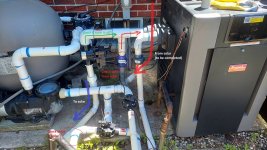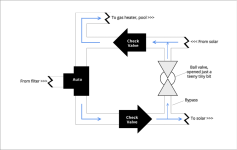I'm almost done with a new solar system and I've got it mostly put together, dry fitting the plumbing. Before I glue everything up, I wanted to get y'all's take on it, make sure there aren't glaring design flaws, etc.
The overview is, there will be five Fafco 2x20 solar collectors stacked beginning at ground level. I didn't want to put it on the roof, partially because I'm concerned by 1.5HP single speed pump can't handle the 20'+ rise. I'm hoping it will be sufficient for the current design, in which the highest the water will get will be about 8-10 feet. The frame I built is at apprx a 30 degree slant, about 30 feet away from the pad. The water will enter the panels at the farthest point from the pump (at the bottom, obviously) and exit at the high point closest to the pump, and then travel the way back to the pump at about 8 or 10 feet above the ground. I have check valves both going from the pad to the solar, and going from the solar back to the pad (it meets back up with the plumbing right before the gas heater, which hopefully will not be needed as often).
Given that the path from the pump to the solar is at the ground level (using flexi-PVC), can the vacuum breaker also be on the ground at the lowest part of the collectors on the exit side (see diagrams)? I've read the threads about vacuum breaker placement but it seems in those cases the solar panels were on a roof. Also, question: I understand that the purpose of a vacuum breaker is to help the solar panels drain when not in use, but where does it drain to on the supply side? Since I have check valves going from the pump to the solar, it seems there's no way for the water to go backwards and leave the panels. Am I missing something? How does it ever drain?
Thanks for any input!
Diagram:

Photo:

Pad detail:



The overview is, there will be five Fafco 2x20 solar collectors stacked beginning at ground level. I didn't want to put it on the roof, partially because I'm concerned by 1.5HP single speed pump can't handle the 20'+ rise. I'm hoping it will be sufficient for the current design, in which the highest the water will get will be about 8-10 feet. The frame I built is at apprx a 30 degree slant, about 30 feet away from the pad. The water will enter the panels at the farthest point from the pump (at the bottom, obviously) and exit at the high point closest to the pump, and then travel the way back to the pump at about 8 or 10 feet above the ground. I have check valves both going from the pad to the solar, and going from the solar back to the pad (it meets back up with the plumbing right before the gas heater, which hopefully will not be needed as often).
Given that the path from the pump to the solar is at the ground level (using flexi-PVC), can the vacuum breaker also be on the ground at the lowest part of the collectors on the exit side (see diagrams)? I've read the threads about vacuum breaker placement but it seems in those cases the solar panels were on a roof. Also, question: I understand that the purpose of a vacuum breaker is to help the solar panels drain when not in use, but where does it drain to on the supply side? Since I have check valves going from the pump to the solar, it seems there's no way for the water to go backwards and leave the panels. Am I missing something? How does it ever drain?
Thanks for any input!
Diagram:

Photo:

Pad detail:



Last edited:







